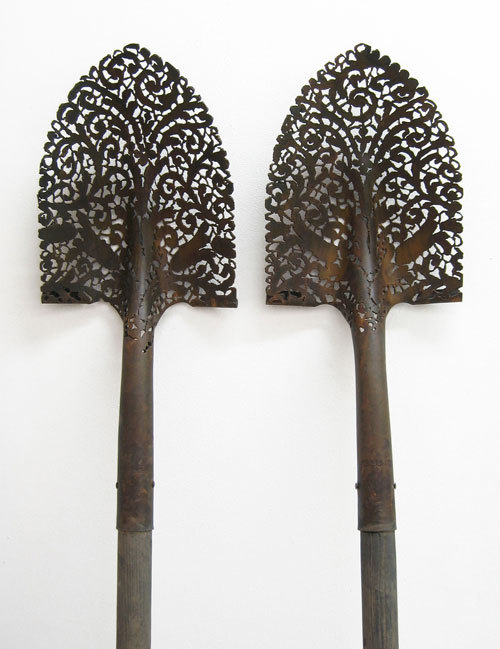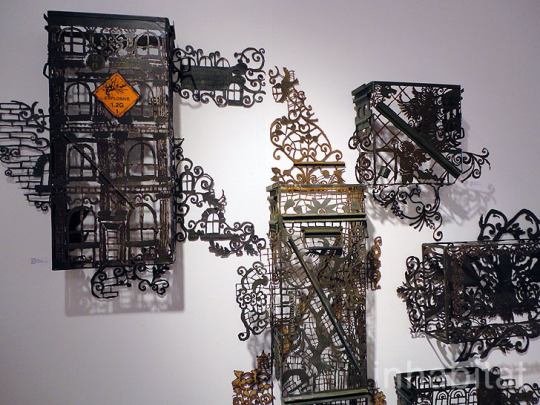Photo








Lace Detailed Steel Objects of Cal Lane
Cal Lane is an artist from Victoria, British Columbia, currently living in New York.
I like to work as a visual devil’s advocate, using contradiction as a vehicle for finding my way to an empathetic image, an image of opposition that creates a balance - as well as a clash - by comparing and contrasting ideas and materials. This manifested in a series of “Industrial Doilies”, pulling together industrial and domestic life as well as relationships of strong and delicate, masculine and feminine, practical and frivolity, ornament and function. There is also a secondary relationship being explored here, of lace used in religious ceremonies as in weddings, christenings and funerals. With this notion of desirable oppositions I created the structure “fabricate”. In this Structure I hand cut lace trimming patterns into 9 I-beams, then constructed a tower, simultaneously macho, and of delicate finery. The metaphor of lace further intrigued me by its associations of hiding and exposing at the same time; like a veil to cover, or lingerie to reveal. It also introduces a kind of humor through the form of unexpected relationships…
Follow her on Facebook.
Hang out and talk about it all with us on Facebook.
posted by Margaret
22K notes
·
View notes
Photo




Imperfections on boards to exhibit work on in college. Makes you appreciate how the surroundings effect the impact and aesthetics of your work. Thankfully the loose material in the first 2 pictures was able to be fixed with a staple gun! The marks on the boards will just have to do.
1 note
·
View note
Photo



Mixture of black oil based printing ink, and wax that broke off pieces of cloth I was printing with that had previously had wax dropped onto them. The surface is a plastic poly pocket which the printing ink was applied to. The poly pocket, with the ink and wax on it, was them placed in a heat press melting the wax and plastic poly pocket, in turn fusing them together. I love the pattern created by the different materials mixing together, as shown in the more zoomed in photos. I'd love to experiment further with fusing various materials and paint together through melting in the heat press, as it would be interesting to explore how materials react, and different patterns and colours would be created.
5 notes
·
View notes
Photo

From when I was busy spray painting my final pieces, it's dirty work!!
5 notes
·
View notes
Photo




Melted plastic poly pockets in a heat press (photo 1) at 200°C between 2 non stick mats, then while the plastic was cooling, I peeled apart the mats in order to distort the plastic, creating the effect shown in photo 2. I then spayed around and over the plastic with spray paints (photo 3), creating photo 4. Turning the plastic over, so that it's spray side down, I then printed the design of the plastic below the sprayed image. I really liked this effect, the intricacy of the design, and the different depths of colour. It's an interesting form of mark making, and putting the poly pockets within the heat press was a very successful technique.
1 note
·
View note
Photo





Exploring the effect of fire on different materials. First picture shows a J2O bottle that was placed in the chiminea earlier to melt and has since cooled in this form. Tried putting a wine bottle in next to see how different types of glass would melt/disfigure in different ways and at different rates. In the other pictures you can see the wine bottle within the chiminea, and how the colour of the glass changes from green at room temperature to red when within the fire (note, the fuel used within the fire was coal, and a mixture of soft and hard woods). It's interesting how one bottle melted completely, disfiguring it to the point where it looks like a lump of glass, and the other merely softened.
4 notes
·
View notes
Photo
Love the patterns and mark making within these pieces, remind me of some of the marks I've been creating with wax and burning materials.





Eric Blum(American, b.1956)
Weft (Nº617) 2011
Untitled Nº624 2012
Assumptions (Nº578) 2009
Pleasure Repair (Nº593) 2010
Glimmer Alert (Nº656) 2012
ink, silk & beeswax on panel
2K notes
·
View notes
Photo



Sewing round areas of a print to add texture, interest to the design. I don't like it because it feels like it doesn't flow. May have been more successful with a sewing machine rather than hand stitch, but I wanted to work with the hessian in order to be in keeping with my other designs.
3 notes
·
View notes
Photo


Experimenting with spray painting round pieces of tracing paper that I’ve previously burnt into, and layering the outlines, to create new shapes, depth of colour and tone. Using chalkboard spray paint as the black pigment is strong.
#spray paint#spray art#chalkboard#paint#template#burn#outline#art#experimenting#light#mark making#shadow
20 notes
·
View notes
Photo

#fire #flames #burn #wood #coal #fuel #chiminea #warmth #garden #light #shadow #shapes #contrast #inspiration #curiosity
#garden#flames#fire#light#burn#shapes#coal#wood#chiminea#curiosity#fuel#shadow#warmth#contrast#inspiration
3 notes
·
View notes
Photo

Experimenting with different ways of applying heat. Held tracing paper over a gas hob allows for a more even spread of heat, which when held at a distance burns the paper but does not cause it to bubble. I like the more varied mark making this technique allows.
0 notes
Photo

Mark making using the heat from the flame of a candle on a larger scale than before. Interested in using layering techniques with this and other materials that have been burned/scorched, wax applied, or printed onto.
2 notes
·
View notes
Photo

Tried burning tracing paper using a blow torch in order to create different marks. Was not successful as the heat is very much directed on one point, and is much more intense than the heat from the flame of a candle. The paper caught instantly and began to burn very quickly.
0 notes
Photo




Inspired by the handsome boys print club, I began experimenting with new ways of mark making on aluminium etching plates, by heating them in a wooden stove.
I was looking to tarnish the surface, however the material began to break down a lot sooner than expected. The temperature gauge reads 185 degrees centigrade, however that is the temperature in the flue, not in the depths of the flames themselves.
In the first image you can see the first plate wedged between pieces of wood, the result of which is the place on the left in the final image. The plate began to disintegrate.
In the second image you can see the second plate laying ontop of the pieces of wood, in order to create a more even heat distribution across the surface, reduce the chance of disintegration, and instead warp the plate. The result is shown on the right in the final image. The plate began disintegrating a little on one corner, but it warped, and when hot, it was placed in the stone surrounding the fire, where you were able to hear by the sound of it hitting the tiles that the chemical composition of it had changed, as it sounded hollow, like you were dropping plastic, not aluminium.
This was an worthwhile experiment but not successful in achieving another path to follow in terms of my final major project as the plates are not able to be printed with. Definitely something to consider in the future however, and would be interesting to experiment with different materials.
6 notes
·
View notes
Photo


Artist - Ingrid Calame
Calame’s work documents “the lowly visual remains of human activity” by taking traces of surfaces, including graffiti, stains, and other human mark, and before overlaying multiple tracings that record the regularized physical movements of people.
The first image is an environmental tracing, showing overlayed surface patterns and textures.
The second image shows tracings up to the L.A. River placed in the Clark Telescope Dome, Lowell Observatory, Flagstaff, AZ. The third image is drawings from the tracing in image 2.
I’m looking at work by this artist as the patterns she has created remind me of maps. I’m inspired by her layering of textures, which in turn creates crossing paths like crossroads and junctions. Some areas also look like contour lines from maps showing the height of the land. This all ties in with my research into street patterns, maps, road layouts.
12 notes
·
View notes















